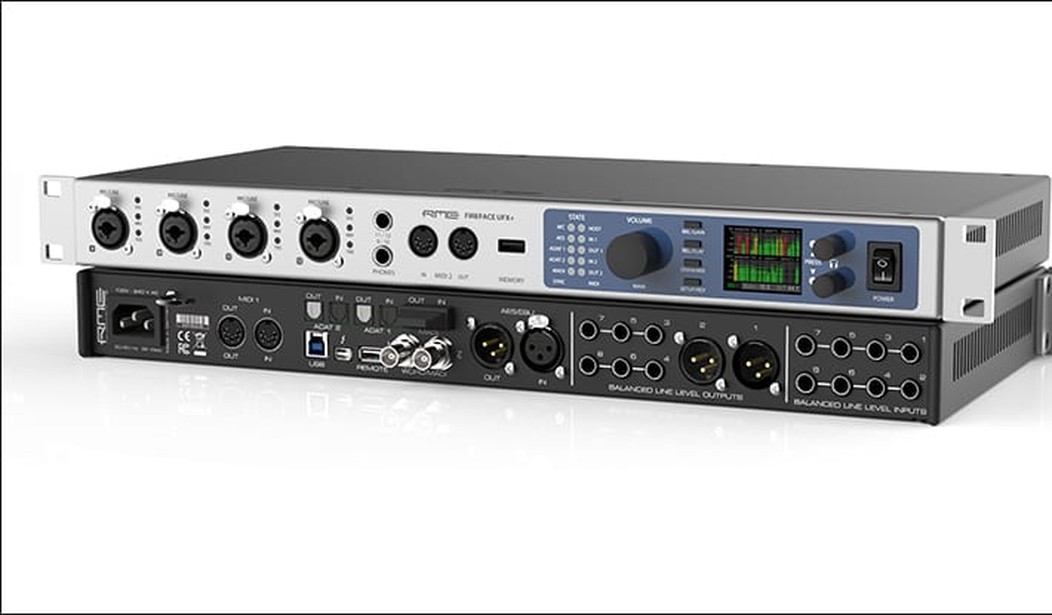Billed as the German RME Audio company’s “20th Anniversary Flagship Interface,” the Fireface UFX+ is a new Thunderbolt-equipped audio interface for Mac and Windows computers, and also iPads. The UFX+ is equipped with four inputs capable of accepting both XLR and ¼” cables on the front of the unit, eight ¼” balanced line inputs on the rear of the unit, six ¼” balanced line outputs and two XLR balanced line outputs also on the rear, plus ADAT, MIDI, and MADI. In other words, this is a powerful core for any computer-based project studio.
The UFX+ supplants the earlier FireWire-equipped UFX interface that RME has been producing since 2011. And I’m basing part of my review on my extensive use over the past four years of RME’s smaller, FireWire-equipped Fireface UCX. All three devices share a common graphical interface, which RME calls TotalMix FX, which is the key to using RME’s products successfully; the obvious big initial difference is that the UFX+ features additional virtual channel strips for its many more inputs and outputs.
Plenty of Inputs, Plenty of Flexibility
Ensemble recording is obviously made easier with those extra inputs, but they’re also surprisingly useful for the one man electronic songwriter. Having say, a stereo guitar interface or two such as Line6’s Pod and Roland’s VG-88, a practice mic or two and/or TC-Helicon’s VoiceLive, and a synth interface all plugged in and ready to go makes cranking out scratch recordings of songs much easier, which can then be refined and polished a track at a time. When both recording and mixing, the TotalMix FX GUI really does feel like a virtual analog mixing desk on a computer monitor.
One downside is that such a powerful GUI can appear daunting at first, but its extensive controls allow for highly versatile routing of audio to and from hardware and software. External processors such as hardware-based compressors and other effects can be inserted to process tracks. I’ve also used the TotalMix FX interface and the inputs and outputs in the rear of the Fireface unit to process vocals after first editing them in Melodyne’s pitch correction software, then sending through to TC-Helicon’s VoiceLive unit, to create massed harmony vocals from a single perfectly-tuned voice.
Extremely Low Latency Possible
Using the Thunderbolt card on my Windows 10 Sweetwater Creation Station PC, the UFX+ is capable of latency as low as 32 samples per millisecond, but to achieve that of course, it helps to record with a minimum of plugins and software synthesizers. Speaking of which, built into the TotalMix FX are plugins allowing for “comfort reverb” into the performer’s headphones when recording, as well as compression and EQ. How much of this you wish to apply during tracking is up to you, but a bit of compression, and rolling off the extreme lows can be helpful when recording a vocal, for example. It’s also possible to use one of the UFX+’s inputs as part of a talkback system, if you’re recording a performer in another room, such as a vocal booth.
The front of the UFX+ comes equipped with four inputs that accept both XLR and ¼” plugs, plus two stereo 1/4-inch jacks for headphones. A switch on the TotalMix FX GUI allows the operator to choose optional phantom power for condenser mics, or ¼” instrument inputs for direct recording of guitar or bass. The front of the UFX+ contains small volume knobs for the two headphone jacks, a larger knob for the primary speakers connected to the rear of the unit (which can be XLR or 1/4-inch equipped), and a USB input for standalone recording to a memory card.
When connected via Thunderbolt, the UFX+ allows the pitch of a recording to be raised or lowered up to five percent, which can be very useful for a vocalist with limited range or technique to sing on top of a recording by adjusting its key.
Multiple Monitor Speakers Make for More Better Mixes
Once a recording is complete, a good mix should be “portable,” and translate over multiple systems. Which is why it’s extremely useful to compare mixes between a set of large high-powered monitors and something a bit more “real world” to determine how a mix will sound on a car stereo system, boom box, and computer monitors. The UFX+ features both a pair of XLR outputs and six ¼-inch outputs, which allows for multiple monitors to compare mixes. I have a pair of large Neumann monitors plugged into the XLR inputs, and much more modest Avantone Mixcubes plugged into a pair of the ¼” inputs. As I mentioned in my review of the Mixcubes last year, they’re based on the old Auratone speakers that were a mainstay of recording studios in the 1970s and ‘80s. The Mixcubes are all midrange, with little bass or treble response. But then the “meat” of a good mix lies in its midrange anyhow, which needs to translate on all systems.
Thunderbolt is Go!
The Fireface’s name is something of a legacy connotation, given that Apple began replacing their FireWire cabling system five years ago with Thunderbolt. For Windows users however, Thunderbolt adds a few complications. In the old days (i.e. 2006), adding FireWire to a Windows desktop PC was pretty easy – just drop in a PCI card, install the drivers, and you were good to go. However, for the large throughput of the Thunderbolt system to work, the PC’s motherboard must be specially equipped, possibly in addition to requiring an ancillary card. When I built my project studio (much more on that story to come in future articles), I purchased a new Sweetwater Creation Station PC with a Thunderbolt connection. However, that PC ships with a Thunderbolt 3 connection, but RME’s UFX+ interface has a Thunderbolt 2 connection, for maximum backward compatibility. To bridge the divide, an external adaptor is needed, and the thick, detailed UFX+ user manual suggests using the Star-Tech TBT3TBTADAP, which I purchased from Amazon, and it did the trick. Once the PC found the UFX+, I found that there were still clicks and other audio interference, until I disabled Wi-Fi on the PC. (Apparently, Wi-Fi is notorious for causing interference with audio interfaces.) For those not yet Thunderbolt-equipped, fortunately, the UFX+ is also compatible with USB 3.0 and 2.0, though the older 2.0 format may cause latency/throughput issues.
One major drawback to the UFX+ is that it’s equipped with only one Thunderbolt connection. That’s fine for those who don’t plan to daisy-chain additional Thunderbolt-equipped devices to their system (and I had no problem integrating the UFX+ into a system with two video monitors connected via DisplayPort and HDMI), but it’s unfortunate that RME didn’t spring for a second Thunderbolt port on the UFX+.
The UFX+ is compatible with the Apple iPad via its class-compliant mode; this Sweetwater demonstration video for the older UCX model explains the basics of hookup to an iPad:
Additionally, the UFX+ also allows for basic recording to a USB stick plugged into the front of the unit, making this a very flexible portable recording platform. But I suspect most users will placing it on the desktops of their project studios.
The UFX+ was first announced in April at Germany’s annual Musikmesse industry trade show, and began shipping to American stores in late September. Concurrent with its announcement was a planned remote control unit; which is scheduled to ship late this month, but will add additional functionality to the equation. With or without it though, the FireFace UFX+ is a powerful audio interface for any PC or Apple-based project studio, and highly recommended for those willing to learn its onscreen interface.










Join the conversation as a VIP Member